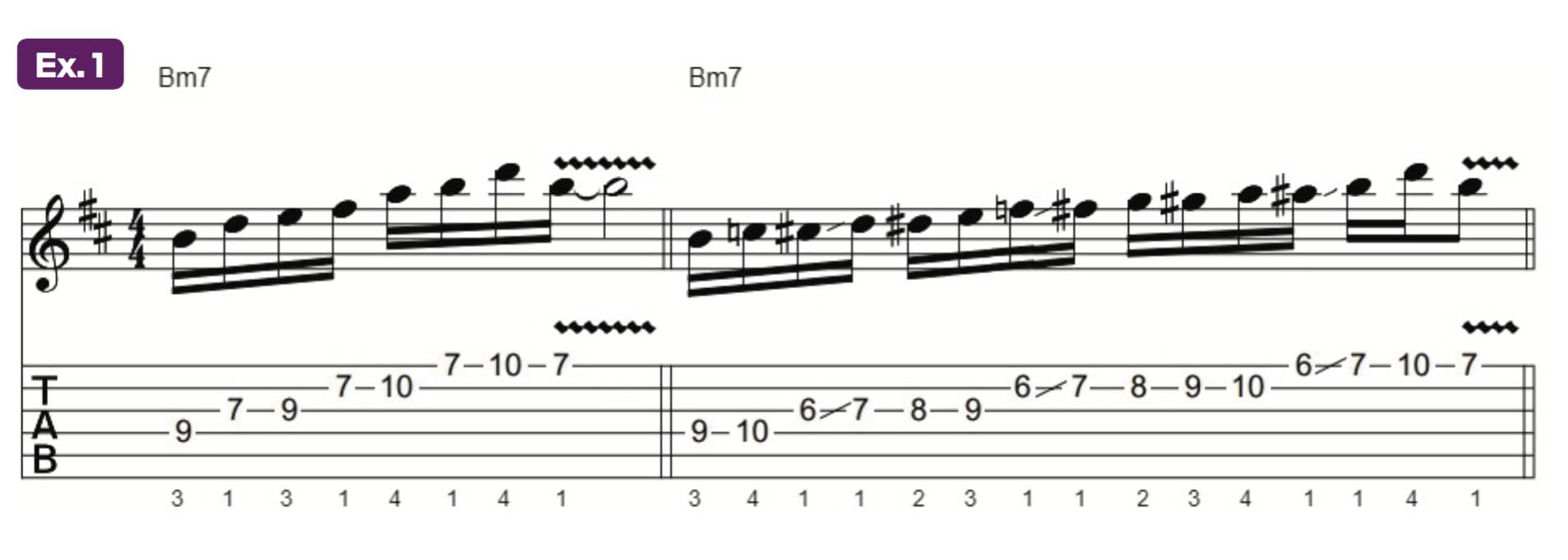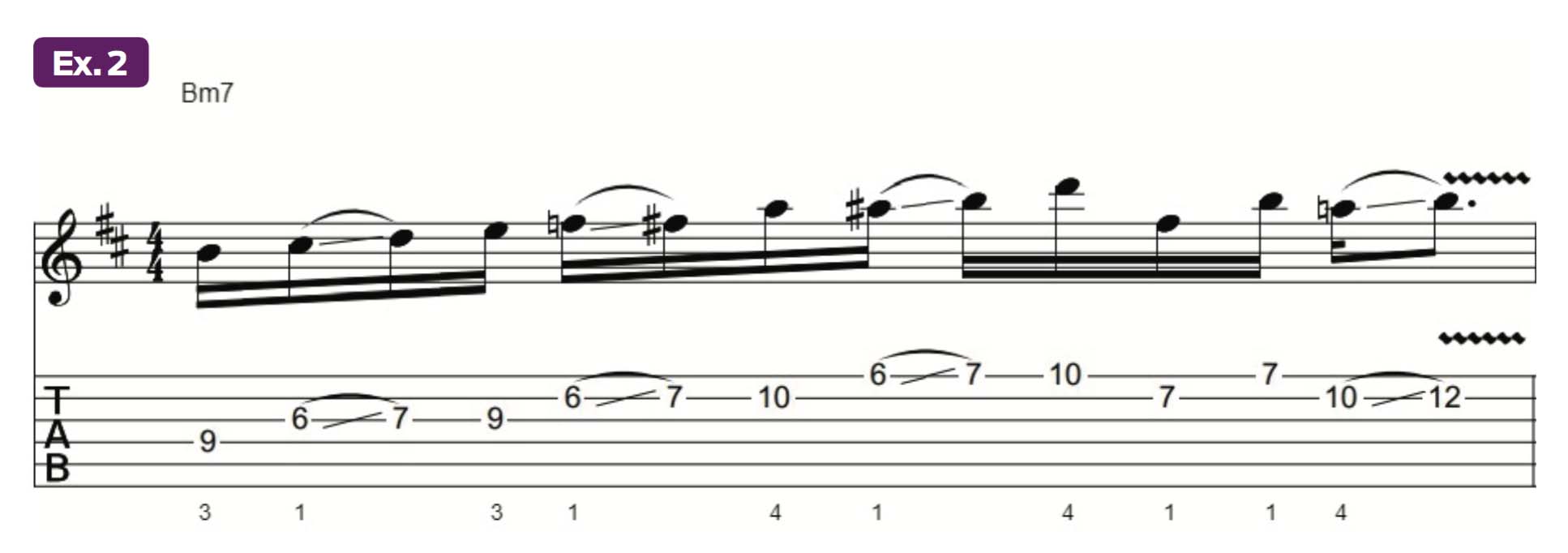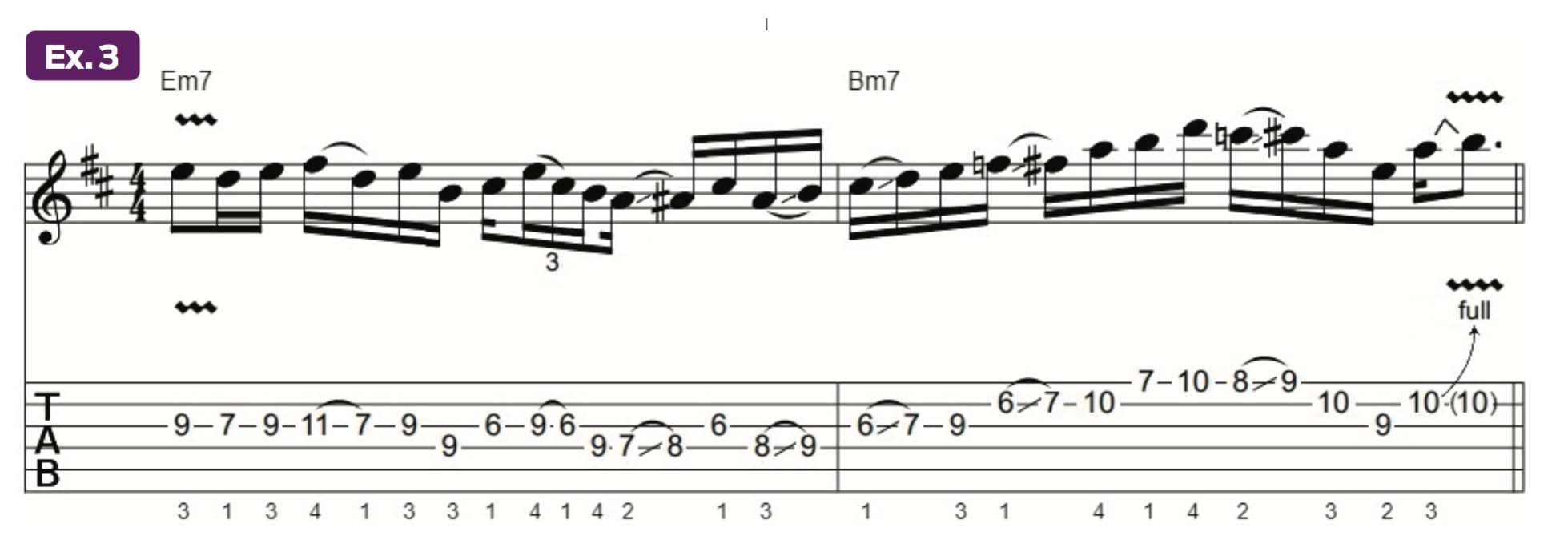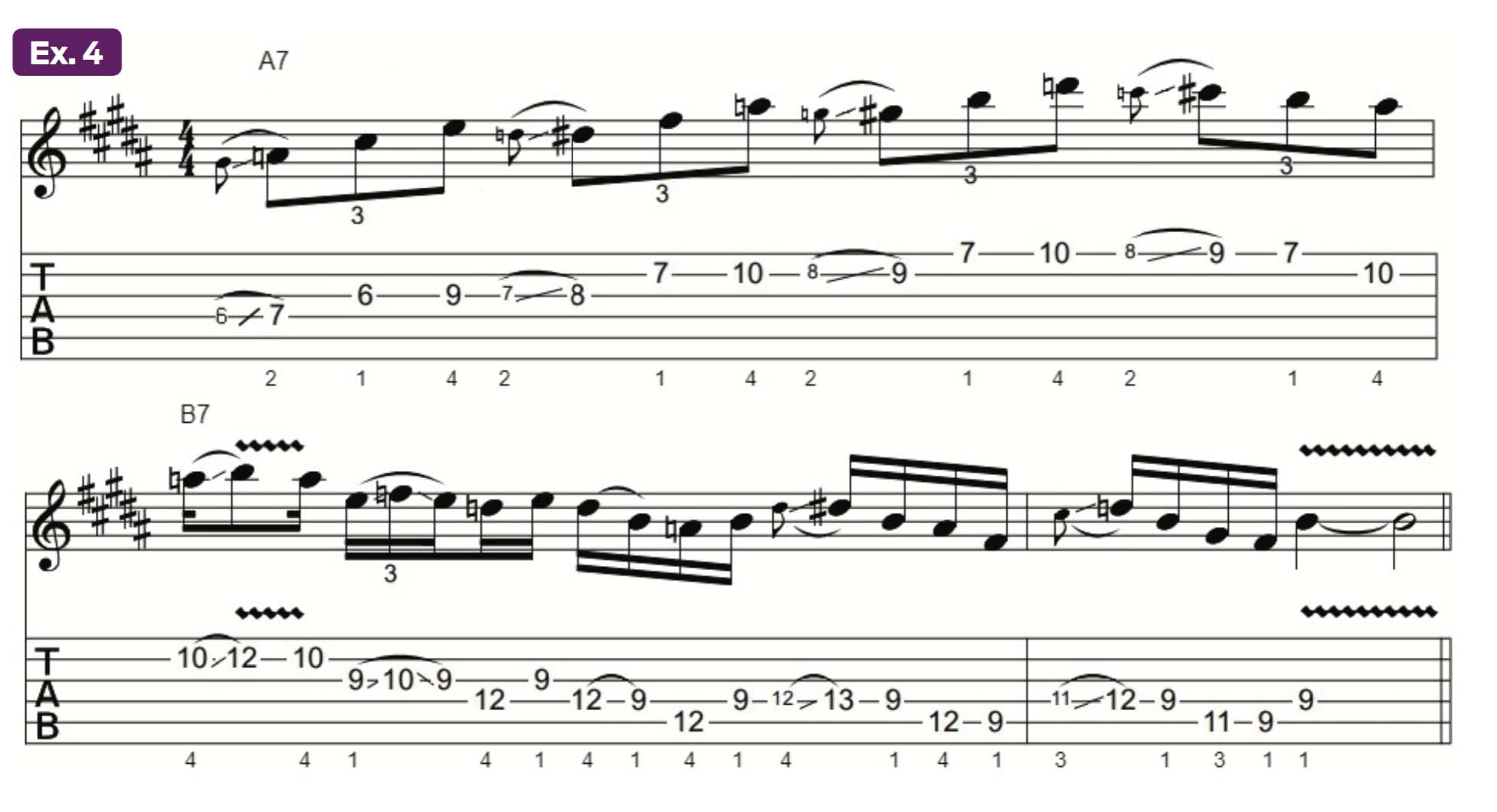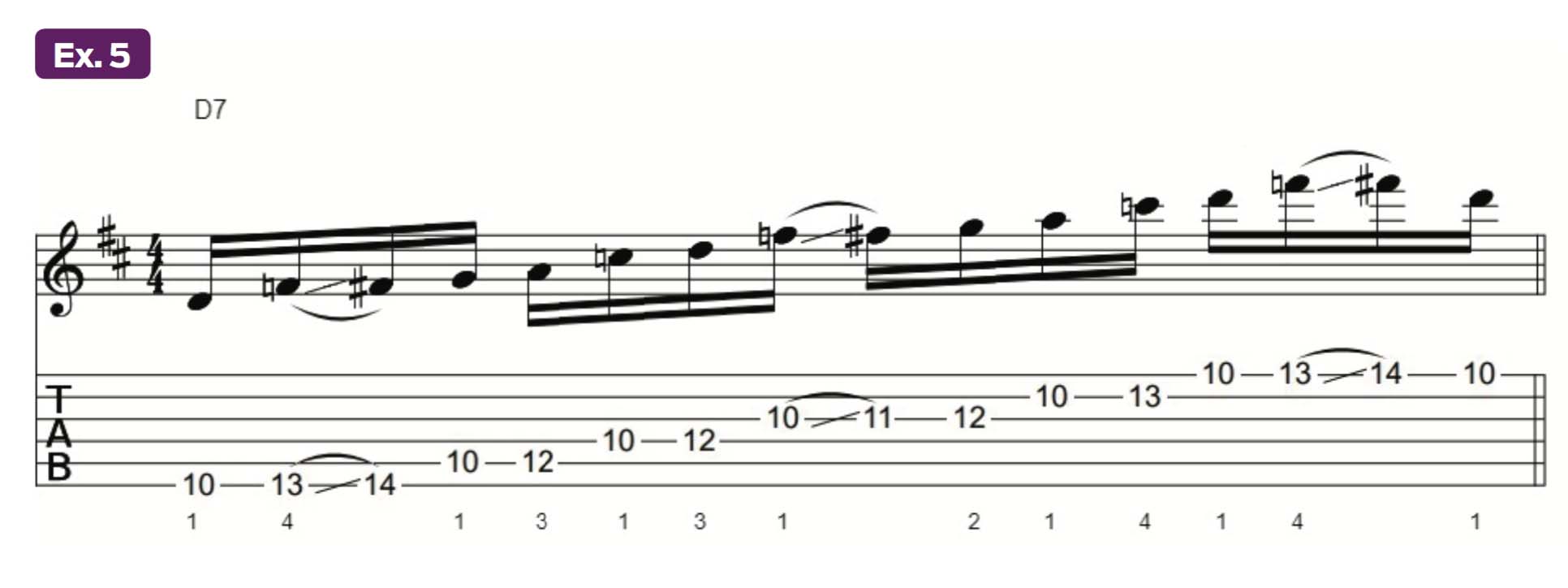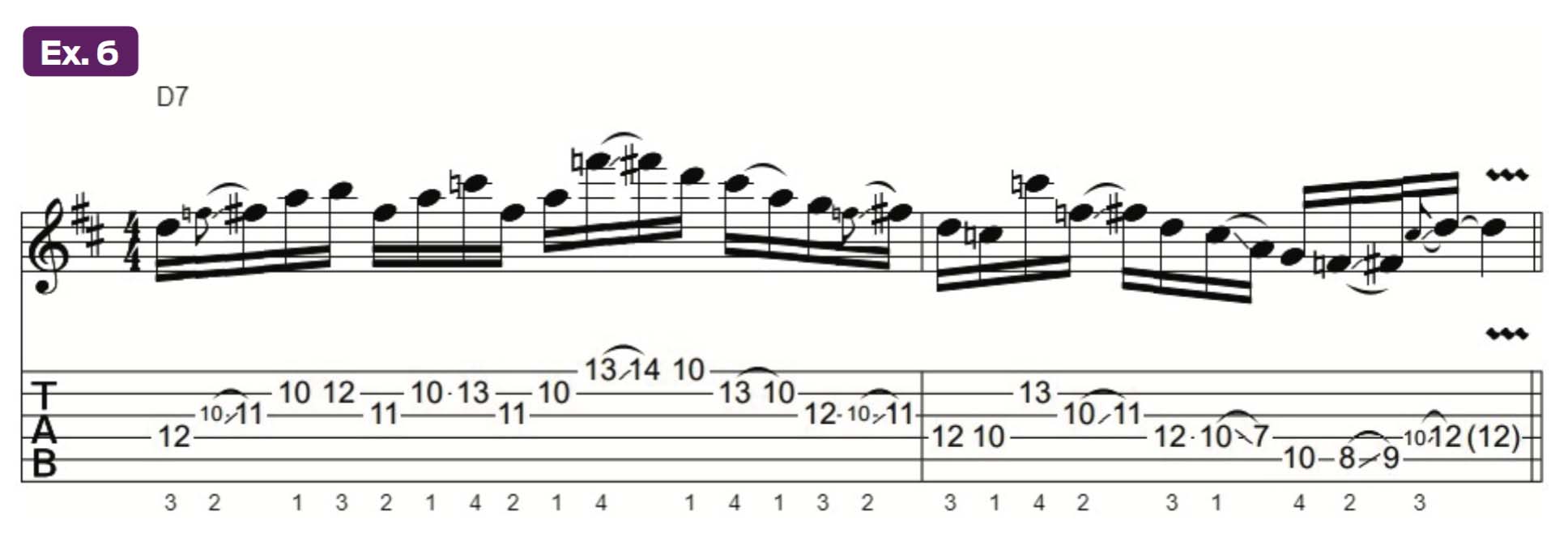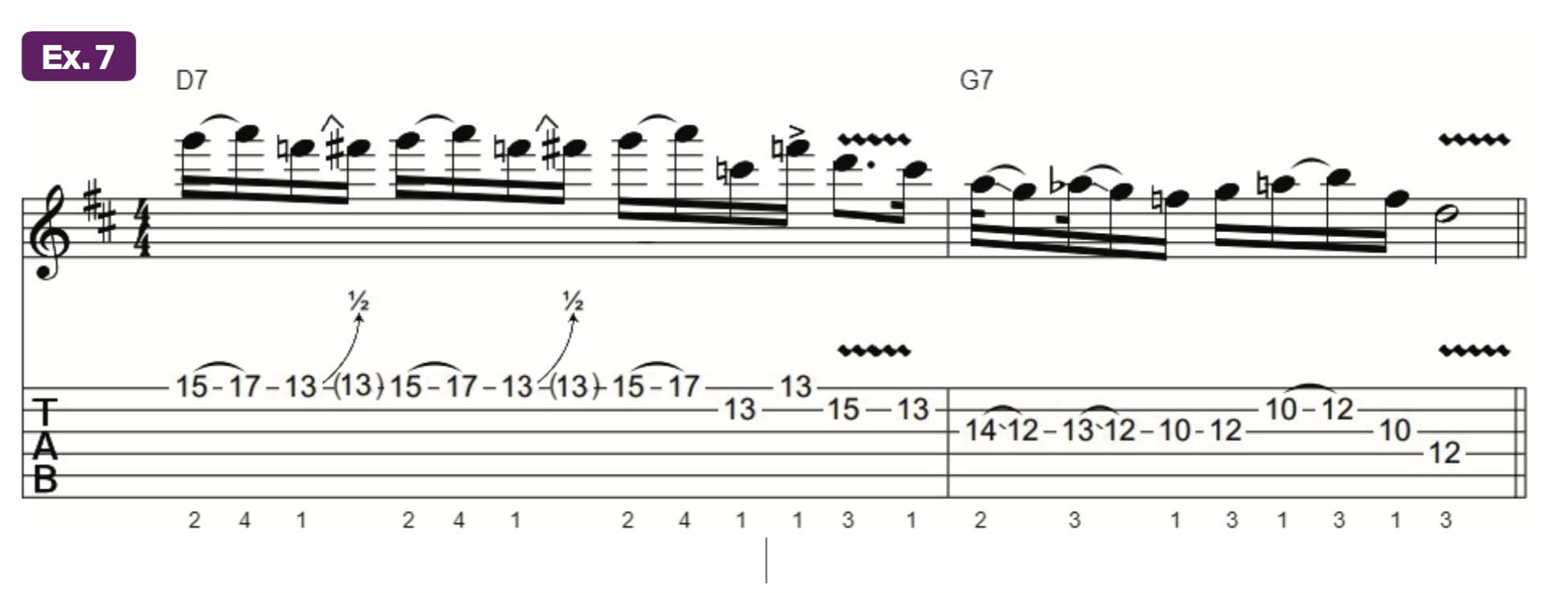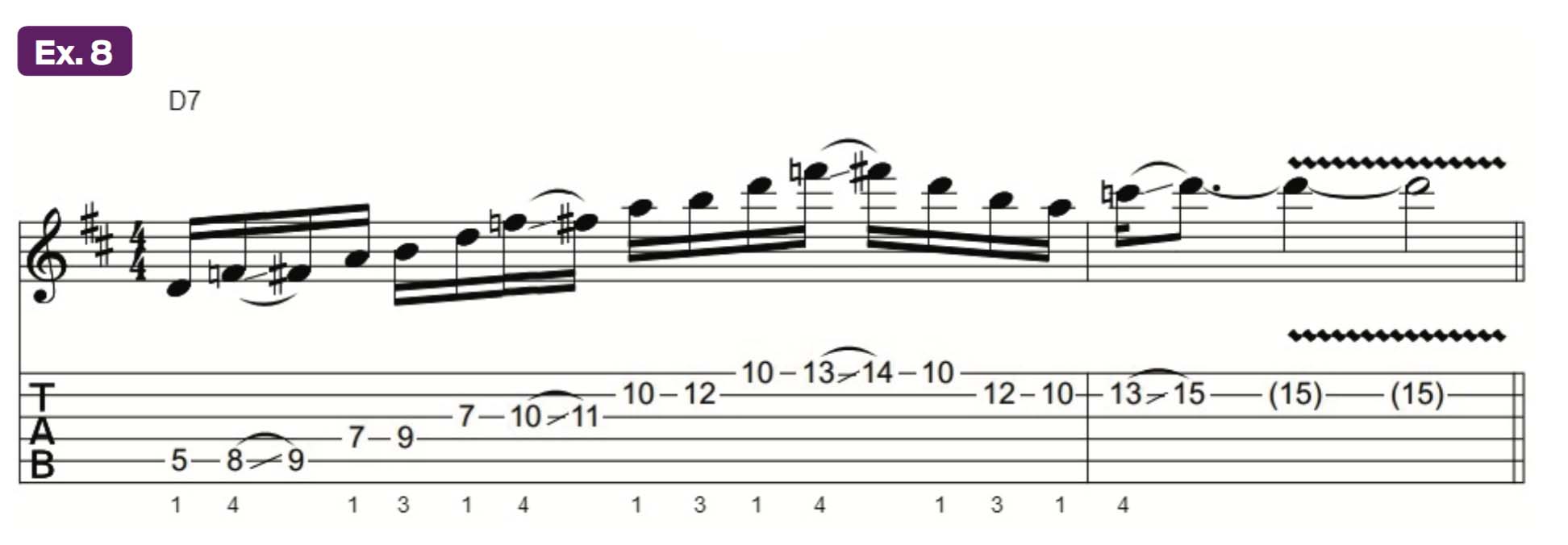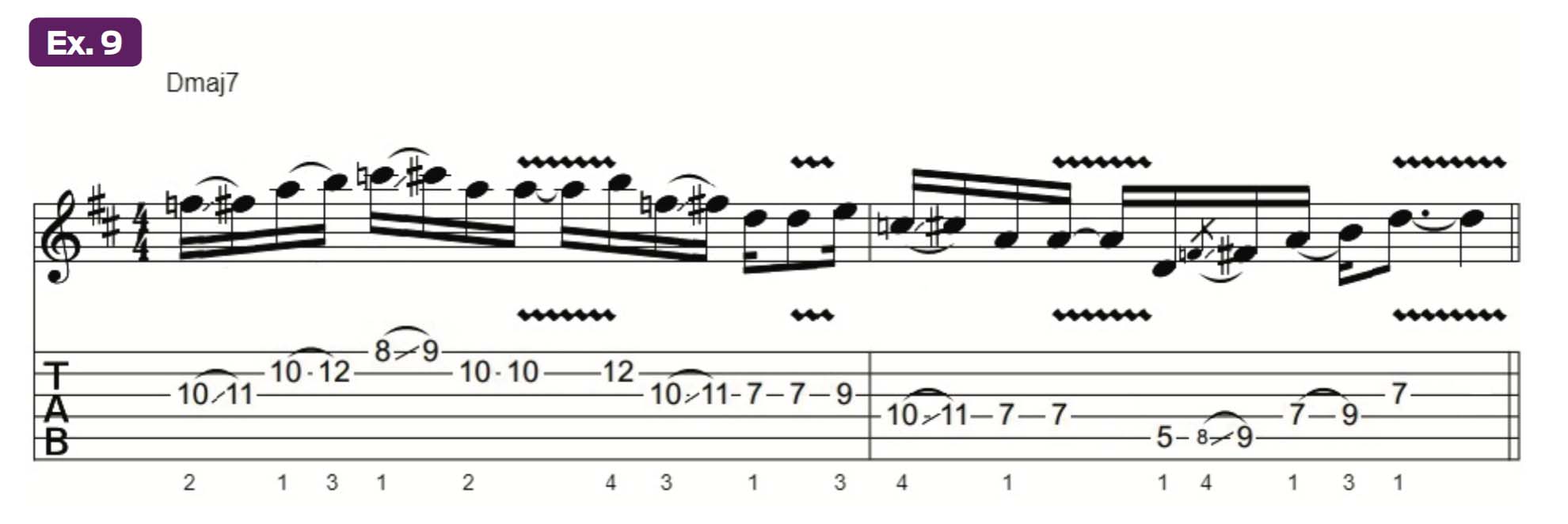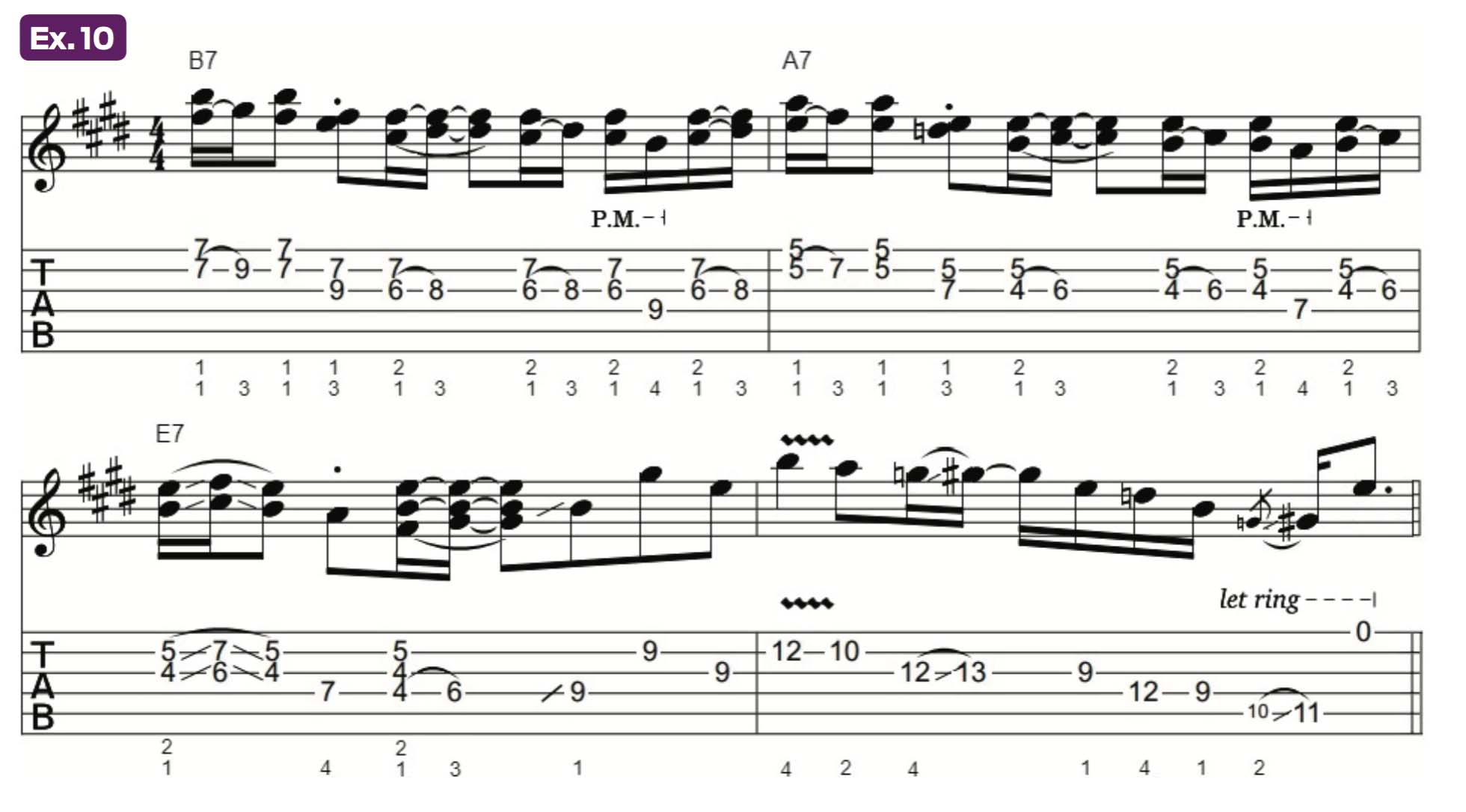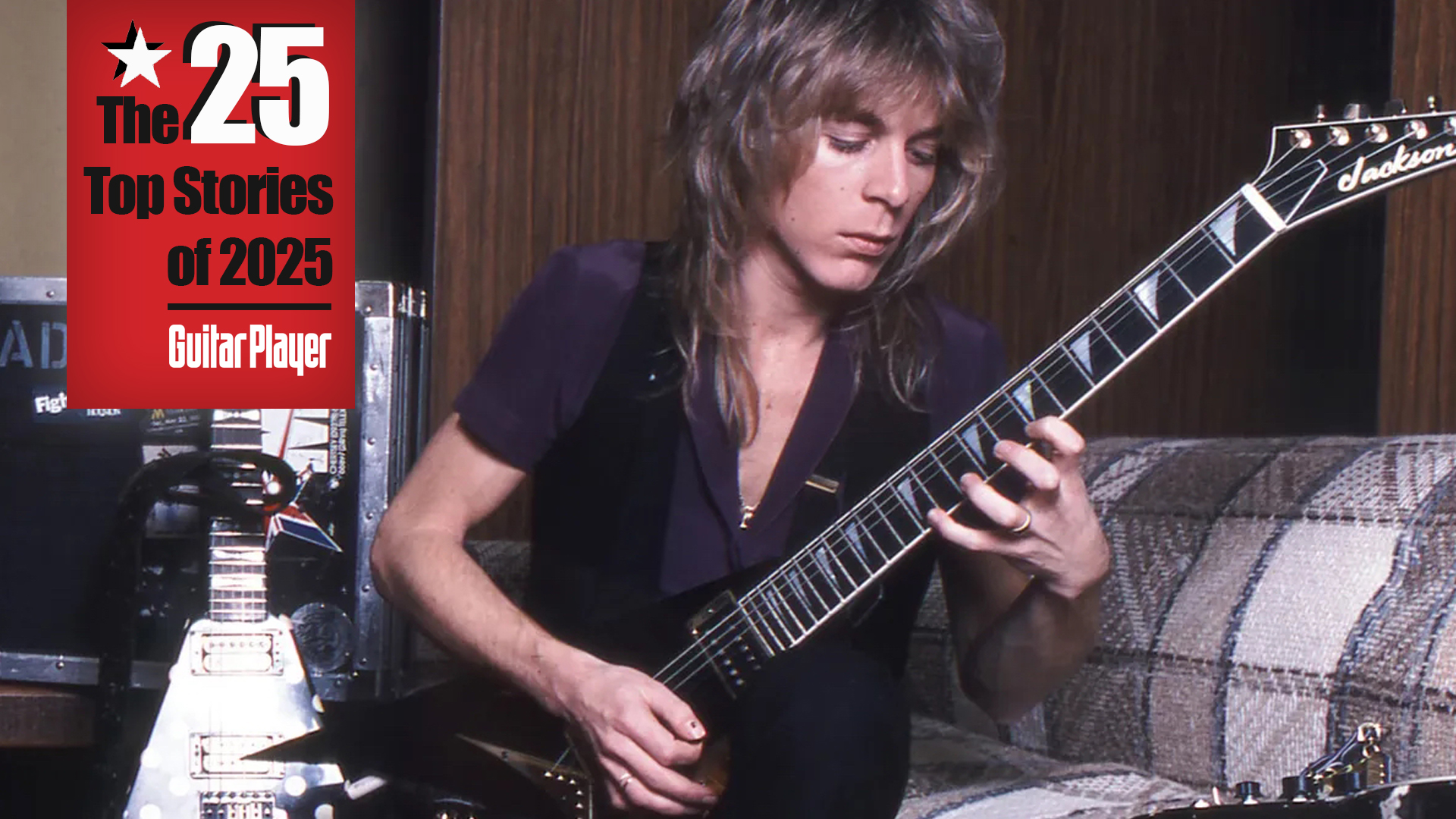A Lesson in Marcus King's Chromatic Passing Tones and Colorful Pentatonic Mutations
King’s signature touch and guitar voice are unique and consistently spot-on.

At the tender age of 15, Marcus King attempted to sneak into the Orange Peel, a concert venue in Asheville, North Carolina, to deliver his demo to Warren Haynes.
A decade later, King has grown into the real deal and established himself as one of the most celebrated young lions on the modern blues-rock scene.
The gifted musical prodigy is brimming with creativity, inspiration and chops, bundled with a soulful touch, earthy, organic tone, and confident and gritty - yet smooth - vocal style that brings to mind that of Gregg Allman, as well as Haynes.
While King’s vocals are impressive and appealing, as is his mature songwriting, it’s the exciting and emotive licks and solos coming from his fingers that are the highlight of his musicality for guitar players.
King’s adventurous approach primarily embraces and displays elements of the classic blues, rock and R&B guitar traditions, along with a good helping of gospel and Memphis soul and some country, jazz and acoustic folk and bluegrass leanings.
His soulful style, especially when it comes to string bending and finger vibrato, reflects the formative influences of such legendary players as Haynes, Duane Allman, Toy Caldwell, Terry Kath, Jimi Hendrix, Dickey Betts and Derek Trucks, among others.

Meanwhile, his more harmonically and rhythmically dense “fusion-y” solos bring to mind the virtuoso playing of such technically advanced players as John Scofield, Eric Johnson, Jimmy Herring and Joe Bonamassa.
All the latest guitar news, interviews, lessons, reviews, deals and more, direct to your inbox!
Whether he’s playing his trusty Gibson ES-345 semi-hollow or his vintage Fender Telecaster, both of which he runs through a split-signal, biamp setup into two tube amps - a Fender Super Reverb and an Orange Rockerverb 50 MKII - King’s signature touch and guitar voice are unique and consistently spot-on.
His growing and increasingly impressive recorded output begins with the Marcus King Band’s inspired debut album, 2015’s Soul Insight, and extends through two EPs and three additional full-length albums released over a span of just five years.
This timeline includes his most recent release, the highly acclaimed solo album El Dorado, which came out this past January.
While the new record focuses a bit more on King’s soulful songwriting and polished vocal chops, it also offers plenty of the tasty licks, burning solos and inspired guitar-driven moments that have distinguished him as one of modern blues-rock’s most exciting and appealing guitarists.

While adding chromatic notes to blues-rock phrasing is nothing new, the ways in which King creatively crafts his lines and manipulates targeted notes creates fresh, original melodic phrases that feature interesting twists.
The guitarist obviously enjoys adventurously pursuing unusual ways of expanding his phrasing outside of the typical pentatonic-based fingerings and scale positions that many players gravitate to, and following these less-traveled paths opens up another level of depth, character and originality in his playing.
If you watch King perform, you’ll notice that he often weaves between positions and goes after notes from outside the standard pentatonic patterns, an adventurous approach that gives his phrases an unusual flow and sound. To explore this yourself, start by modifying the structure of the tried-and-true minor pentatonic scale.
While the simple, sparse framework of this five-tone entity is a big part of what makes it so useful and appealing, it also presents seemingly endless opportunities for variations and mutations that can be applied to it, which is no doubt why it's the most frequently used scale on the guitar.
Ex. 1 gets the ball rolling by first showing a one-octave fragment of a 7th-position “box” pattern and fingering for the B minor pentatonic scale (B, D, E, F#, A), followed by an overlaid chromatic scale played in the same position and starting on the same B note, with finger slides liberally employed to smooth out the articulation.
This template serves as a good basic example of how King will often “connect the dots” within a minor pentatonic framework by filling in the spaces with various approach notes and color tones.
Ex. 2 offers a King-style phrase based on this same B minor pentatonic box pattern, with a few chromatic lower neighbor tones added via the 1st finger dropping back to the 6th fret then sliding up to the 7th fret to target the b3rd, 5th and root (D, F# and B) from a half step below, with the 2nd (C#), b5th (F) and 7th (A#), respectively.
Notice how these added chromatic notes lend a touch of dissonance and breathe new life into the standard and relatively tame-sounding minor pentatonic tonality.
The jazzy flavor of the previous example paves the way for the intriguing sounds emanating from Ex. 3, which combines busy rhythmic-melodic movements with a plethora of chromatic approach tones, resulting in a smoothly rolling and tastefully twisted phrase that sounds great over the iv - i chord change in the key of B minor (Em7 - Bm7).
As you play through and study this example, notice that we’re reaching for notes outside the foundational B minor pentatonic box shape in bar 1, followed by a series of chromatic shift-slides that borrow a few of the moves presented in the previous example.
This phrasing approach is appealing and can inspire all sorts of unique sounds and interesting lines. For further inspiration, listen to King’s similarly adventurous and jazzy playing on the jammy instrumental cuts “Fraudulent Waffle” and “Booty Stank,” from Soul Insight.
Ex. 4 offers another King-inspired twist on adding decorative chromatic notes to foundational fretboard shapes.
Played over a bVII - I progression in the key of B (A7 - B7), the phrase starts off in bar 1 with an arpeggio-based structure and diminished-like triad shapes, followed by a bluesy descending phrase over B7 in bar 2 that combines notes from the B blues scale (B, D, E, F, F#, A) with those of B major pentatonic (B, C#, D#, E, F#).
Bar 2 is also inspired by King’s signature quirky half-step sliding movements that bring to mind Derek Trucks’ slide playing, although King will often perform these sitar-like embellishments with his fingers.
Switching to the key of D, Ex. 5 is a two-octave ascending run based on the D “dominant pentatonic” scale (D, F#, G, A, C) in 10th position, with the b3 “blue note,” F, added as a chromatic approach note to the major 3rd, F#.
This pentatonic alteration and addition can often be heard in King’s playing, as well as that of rock guitarists like Jeff Beck, Steve Lukather and John Petrucci, to name a few.
This slight modification to the minor pentatonic scale allows it to sit quite comfortably over dominant 7 chords and related progressions, thanks to the chromatic “blur” between the minor and major 3rds.
To give your fingers a chance to explore this modified pentatonic scale, Ex. 6 offers a sample phrase in the key of D that demonstrates some of King’s oft-used melodic devices, including the aforementioned half-step finger slides from the minor to the major 3rd (F to F#), as well as frequent changes in the direction of the line and wide intervallic jumps, which create interesting, angular contours.
King is quite adept at crafting expressive lines like this, and you can hear him doing that in songs such as “Plant Your Corn Early” and “Jealous Man,” both featured on his 2016 album, The Marcus King Band.
Also in the key of D, Ex. 7 offers another twist on this concept of combining parallel scales - different scales that begin on the same root - to craft colorful phrases, this time with a line played over a I - IV progression (D7 - G7).
Bar 1 connects adjacent D minor pentatonic box fingerings on the high-E string with some half-step bends from F to F#, performed with the index finger. Bar 2 combines notes from the D blues and D major pentatonic scales, which work well and take on different harmonic functions as the backing chord shifts to G7.
Notice the implied G7 arpeggio (G, B, D, F) performed at the end of the phrase, which provides a strong, satisfying conclusion to the phrase.
King knows his theory, even if just intuitively, through his highly developed musical ear, and is keenly aware of the chord changes occurring in his music, and he’ll often set up phrases like this when soloing over changes, authoritatively acknowledging and describing the underlying progression.
Listen to such tracks as “Boone” and “Honey,” from Soul Insight, for great examples of this unique kind of tasteful, effective phrasing.
Another noteworthy characteristic of King’s lead playing is the way he’ll seamlessly traverse the fretboard and connect ideas and shapes without pausing, often by using finger slides and position shifts to transport his fretting hand up and down the neck and perform extended, multi-octave runs, like that shown in Ex. 8.
This phrase is based on a D6 arpeggio (D, F#, A, B), which is essentially the D major pentatonic scale, minus the 2nd, or 9th, E. But notice the inclusion of the b3, F, which again is used as a lower-neighbor approach tone to the major 3rd, F#.
The F note may alternatively be thought of as the #2, or #9, E#, which would give you a mutated scalar entity that you could call “D major pentatonic #2.” Whatever you call it, it has that cool blues-rock sound.
King has a knack for building a feeling of momentum in his improvisations, which he’ll often achieve with seamless position shifting and erratic fret-hand movements, as these examples demonstrate.
If you watch him solo live, you’ll notice that he often glides and shifts his fret hand up and down the neck, and bridges multiple fretboard positions with apparent ease. These examples presented in his style will give you some insight into tackling this kind of exciting and adventurous free-roaming approach.
Ex. 9 is inspired by several phrases that King plays on his cover of the Marshall Tucker Band classic, “This Ol’ Cowboy,” as featured on the Marcus King Band’s powerful 2017 EP, Due North.
Based primarily on D major pentatonic shapes, the single-note line incorporates some expressive finger slides and vibratos over a Dmaj7 chord, creating a soulful, jazzy feel.
As you study this phrase, notice the mirrored movement occurring between the minor and major 3rd (F and F#) on the G string and the minor and major 7th (C and C#) on the D string, and be sure to employ the prescribed fingerings, to ensure a smooth performance.
Our final offering, Ex. 10, pays tribute to King’s soul and R&B influences, most notably Jimi Hendrix and Curtis Mayfield.
It exemplifies how King will use notes from the six-note major hexatonic scale, which adds the 4th to the major pentatonic (1, 2, 3, 4, 5, 6), to craft elegant, gospel-flavored doublestop phrases with oblique hammer-ons, as well as finger slides, moving through a V - IV - I (5 - 4 - 1) progression in the key of E: B7 - A7 - E7.
Bar 1 sets up a cascading phrase based on the B major hextatonic scale (B, C#, D#, E, F#, G#) that’s then transposed down a whole step and two frets in bar 2 to A major hextatonic (A, B, C#, D, E, F#).
This leads into a two-bar idea built from E major hexatonic (E, F#, G#, A, B, C#), played as single notes, double-stops and triple-stops, with the b3 - or #9, G - adding a bluesy flavor.
The line comes to a tasteful conclusion with a G-to-G# finger slide that’s followed by, and rings together with, the open high-E string, which is hybrid-picked.
You can hear similarly emotive and expressive double-stop phrasing on the tracks “Homesick” and “Side Door” from King’s 2018 album, Carolina Confessions, which beautifully showcases his blues and soul influences.
It takes a lot of practicing, listening and jamming to acquire the skills and experience required to improvise with the finesse, control and conviction that King displays in his playing.
Spend some time studying the examples presented in this lesson and use them as springboards for your own original licks and runs.
A guitarist like Marcus King has obviously devoted a great deal of time learning from others and honing his technique and talents, so let his music inspire and inform your own creative musical endeavors.
